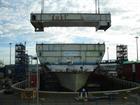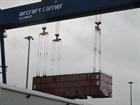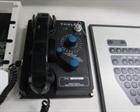Carrier update October
Prince of Wales
On 2 October, the formal handover took place of the last parts of centre block CB02. Rings CB02 F&G left Merseyside 7 October and were ferried to Rosyth arriving 12 October. The rings are 40 metres wide, 15 metres deep and 10 metres tall, with ring F weighing in at 942 tonnes while G is 642 tonnes.
Assembly continued with lifts of CB02 & 03 blocks 14 October and CB02 D&E blocks on 23 & 24 October. ACA is waiting to fill the non-tidal basin with enough water to allow the CB02 F&G rings to be offloaded safely towards the end of October. These are the last pieces of the jigsaw which will allow the skidding together of the two super-blocks LB02/03 early next month.
Outside Rosyth, the only blocks still to be completed are for the stern of the carrier; LB04 which is being constructed on the Clyde and CB04 blocks on Merseyside, scheduled to be handed over Summer 2015.
HMS Queen Elizabeth
October has been another busy month for the Mission System Blown Fibre team with the completion of patching activities across damage control zones one to three. Patching is the activity whereby routes are formed for the fibres to be blown down. Eventually, there will be 1,730 routes formed totalling 340,284 metres across HMS Queen Elizabeth with each route carrying two or four fibres. Blowing across the whole of the ship is due to be completed in June 2015. The fibre optics being installed form the network infrastructure which supports data, voice and video on the ship. This patching activity comes on the back of the completion of the installation of all of the protected microduct across damage control zones one to three during September.
Queen Elizabeth is now HV live, supplied with shore-based High Voltage (HV) electricity for the first time. which means onboard commissioning and testing can start in earnest ahead of autonomous power from the ship’s generators coming on-stream next year.
The many integration tasks continue including the back up to the back-up communication systems. 17 Self powered telephones (SPT) have been fitted to HMS Queen Elizabeth. In total, there are 183 SPTs to be fitted throughout HMS Queen Elizabeth as the fall-back / recovery communications should the primary communication systems (e.g. voice over IP phones, Tactical Command and Control Voice (TC2V), Wireless Communication System and Broadcast and Alarms) fail or become degraded. The first six Combat Management System (CMS) consoles have been delivered to HMS Queen Elizabeth operations room. Arriving flat-packed, the consoles were assembled by a team comprising personnel from Babcock, BAE Mission Systems, BAE New Malden, BAE Hillend and the Royal Navy. In total, there will be 36 CMS consoles delivered to the Ops Room, representing a combination of Tactical and ATC Consoles and General Purpose Desks.
The unique twin islands of the QE class of carrier means that the ship has a dedicated rear island to direct air operations, while the forward island and bridge controls the ship’s navigation. Both islands are designed to switch functionality if required, giving the carrier a key redundancy factor in an operational environment. The glass flying control position (or FLYCO), fitted onto the rear (aft) island, is the operational centre controlling all air operations and is closely linked to the ship’s operations room, navigation bridge, flight deck and hangar operations centre.
As part of its aviation lead responsibilities, Thales led the procurement of the FLYCO from the Special Projects division of Ipswich-based key supplier Tex ATC Ltd, one of the world’s leading providers of military and civilian airfield visual control rooms. The FLYCO position provides the operators with an unparalleled operational working space, with three metre tall specially glazed panels, giving more than 290 degrees of view over the flight deck. The multi-layered glass – designed to provide solar and noise protection – is also incredibly strong, so strong that it could withstand a strike equivalent to a direct hit from the blade of Chinook helicopter.
About this time last year ACA committed to delivering supply chain savings across the programme in 2014 of approximately £86 million. Ahead of schedule they’re so confident of making the £86 million – they’re actively looking to hit £100 million.










